Alcohol, Analytics, Lithuania, Statistics
International Internet Magazine. Baltic States news & analytics
Friday, 19.04.2024, 15:12
Lithuania: Alcohol and tobacco consumption and consequences thereof, 2018
 Print version
Print versionFig. 1. Consumption of legal alcohol
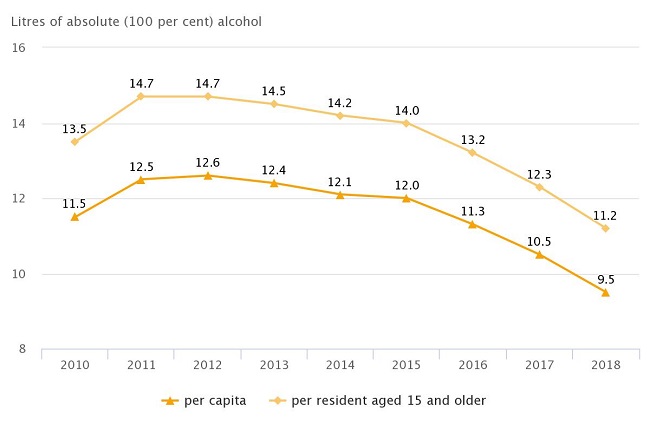
Legal alcohol sales, prices, production, imports, and exports
In 2018, country’s retail trade and catering enterprises sold 2.9 mln dekalitres of spirits (vodka, whisky, brandy and the like), which is by 153 thousand dekalitres (5%) less than in 2017, and 3.4 mln dekalitres of wine and fermented beverages, which is by 823 thousand dekalitres (19.5%) less than in 2017. Just as every year, the bulk of sales fell within beer – 21.9 mln dekalitres, or by 1.4 mln dekalitres (5.9 %) less than in 2017.
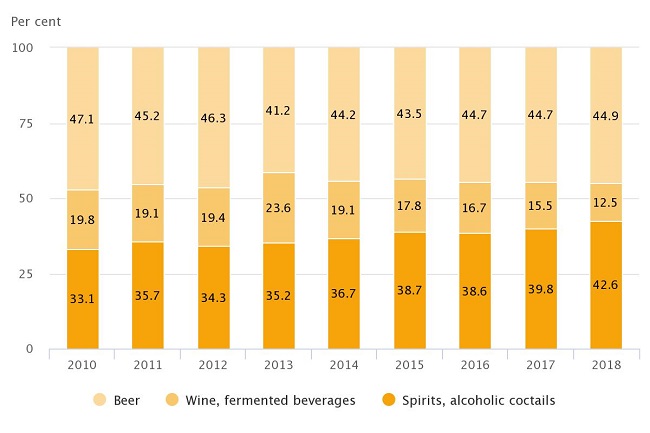
- In 2018, against 2017, retail prices of alcoholic beverages grew by 2.1%, with the largest increase observed in prices of beer produced in Lithuania – 4.8, imported beer – 4, bitter – 3.9, vermouth – 3.8, vodka produced in Lithuania – 3.1%, while whiskey went down in price by 2.5%. The growth in prices of alcoholic beverages was conditioned by a higher excise duty applied since 1 March 2018.
- In 2018, 0.963 million dekalitres of spirits, expressed in terms of absolute (100%) alcohol, were produced in Lithuania. Against 2017, their production decreased by 6.7%. In 2018, production of grape wine and vermouth amounted to 0.47 mln dekalitres, or by 14.8% more than in 2017. The production of fermented beverages amounted to 4.7 mln dekalitres, which is by 13.4% less than in 2017. In the group of fermented beverages, decrease was recorded in the production of non-sparkling beverages (47.6%), cider (43%), fruit and berry wine (17.1%), and increase – in the production of sparkling fermented beverages (3.5%). Beer production accounted for the largest proportion – 28.5 mln dekalitres; however, over the year, it decreased by 3.8%.
- In 2018, against 2017, the largest increase was observed in imports and exports of spirits (10.8 and 25.8% respectively) and beer (14.6 and 5.3% respectively). Imports of fermented beverages decreased by 14.3%, exports – increased by 5.1%; imports and exports of wine decreased by 7.4 and 8.5% respectively.
- In 2018, against 2017, a decrease in the production, imports, exports and sales of alcoholic beverages, expressed in terms of absolute (100%) alcohol, was observed.
Fig. 3. Trends in production, imports, exports and sales of alcoholic beverages in terms of absolute (100%) alcohol
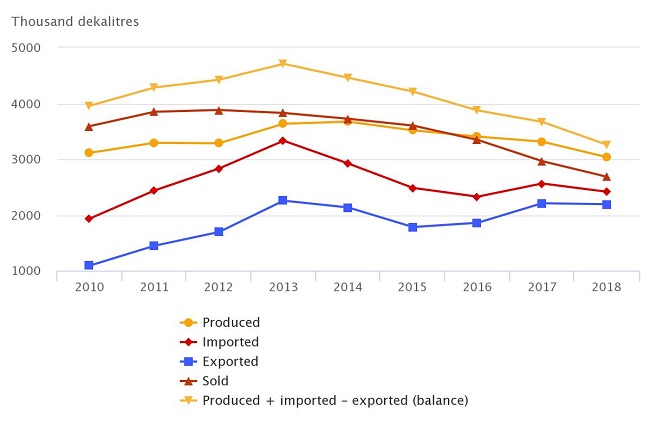
Consequences of alcohol consumption: prevalence and mortality
- According to the data of the Institute of Hygiene, based on the Compulsory Health Insurance Fund Information System, in 2018, 24.2 thousand persons were diagnosed with at least one disease directly linked to alcohol consumption, or 863 persons per 100 thousand population (in 2017, 908). The most frequent diagnoses were alcoholic dependence (599.9 cases per 100 thousand population), toxic effect of alcohol (169.5 cases per 100 thousand population), and alcoholic psychosis (93.8 cases per 100 thousand population). Against 2017, prevalence of alcoholic psychoses decreased by 10.8%, prevalence of toxic effect of alcohol decreased by 5.4%, prevalence of alcoholic dependence decreased by 3.7%. The prevalence of diseases directly linked to alcohol consumption is the highest among men aged 35–39, which exceeds that among women more than 3 times. The highest prevalence for rural residents is observed in the 35–39 age group; for urban residents, the peak of prevalence is reached later – at the age of 45–49.
Data provided by the Institute of Hygiene
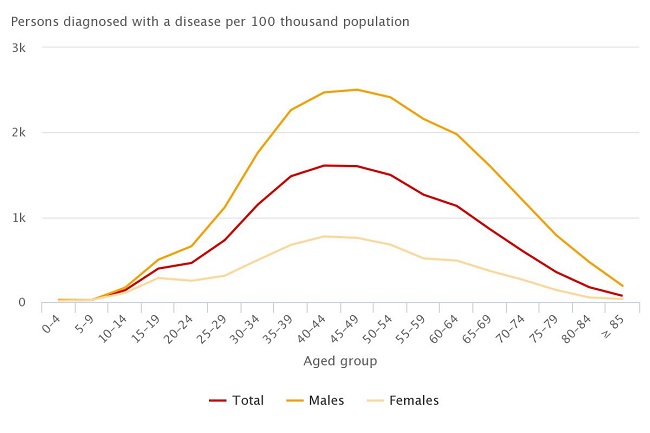
Data provided by the Institute of Hygiene
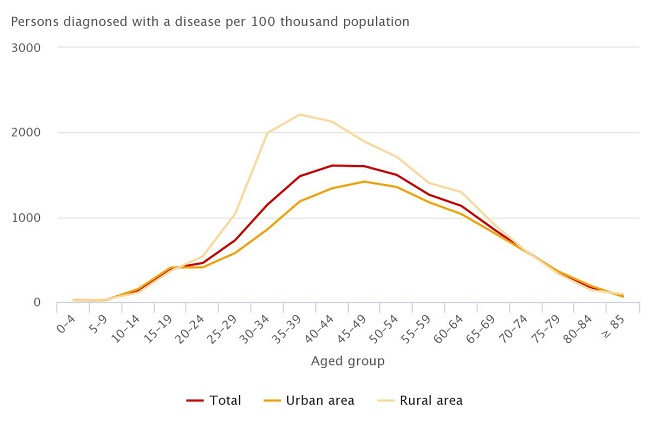
- According to the data of the Institute of Hygiene, in 2018, 507 persons died from diseases directly linked to alcohol consumption, which is by 69 less than in 2017. The most frequent alcohol-related diseases were alcoholic liver disease (44.4%), accidental poisoning by and exposure to alcohol (31%) and alcoholic cardiomyopathy (10.5%).
Fig. 6. Mortality due to diseases directly linked to alcohol consumption
Data provided by the Institute of Hygiene
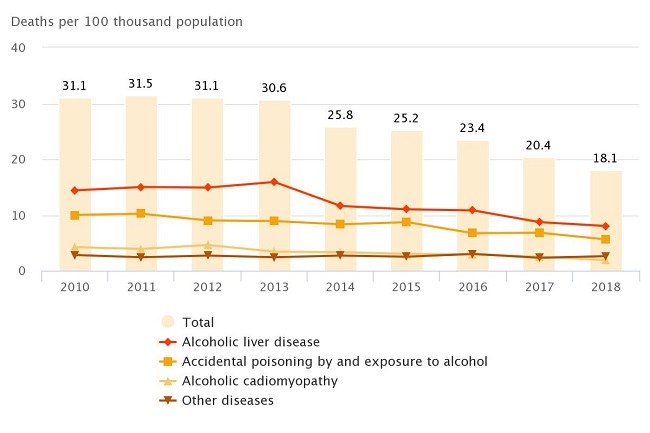
- In 2018, based on provisional data, male mortality due to diseases directly linked to alcohol consumption was 3.2 times as large as female. In 2018, the number of deaths due to alcohol consumption per 100 thousand urban population amounted to 18 (in 2017, 20), per 100 thousand rural population – to 20 (in 2017, 22).
Fig. 7. Male and female mortality due to diseases directly linked to alcohol consumption, liver cirrhosis and fibrosis
Data provided by the Institute of Hygiene
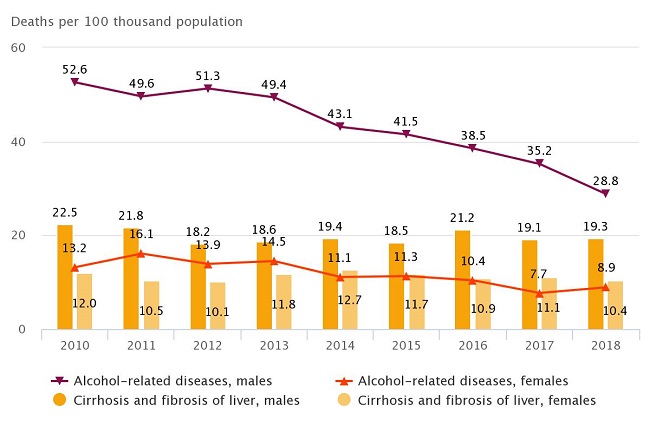
Criminal offences committed and road traffic accidents caused by drunk persons, accidents at work, families at social risk
According to the data of the IT and Communications Department under the Ministry of the Interior, in 2018, 30% (10.8 thousand) of criminal offences investigated were committed by persons intoxicated by alcohol. Against 2017, the number of such criminal offences increased by 1 thousand (10.3%).
According to the data of the Police Department, in 2018, each tenth road traffic accident was caused by a drunk person: 347 (in 2017, 336) road traffic accidents through the fault of drunk persons were registered, with 63 persons killed and 492 injured. In 2018, 22 persons were killed and 257 – injured in road traffic accidents caused by drunk drivers. In 2018, against 2017, the number of road traffic accidents caused by drunk persons increased by 3.3, of those caused by drunk drivers – increased by 10%.
According to the data of the State Labour Inspectorate, in 2018, 37 persons died in accidents at work, of them 5 were intoxicated persons (in 2017, 37 and 5 respectively).
According to the data of the Child Rights Protection and Adoption Service, at the end of June of 2018, 3.6 thousand drinking families at social risk raising children were on the record of municipal child rights protection services (branches) (by 0.3 thousand, or 7.7%, less than at the end of 2017), with 6.6 thousand children raised in them. Over the year, the number of children raised in such families decreased by 0.5 thousand (7%).
Legal tobacco products consumption, prices, production, imports, exports and consequences of consumption
- In 2018, 1,164 cigarettes were purchased in retail trade and catering enterprises per resident aged 15 and older (by 3.2% less than in 2017).
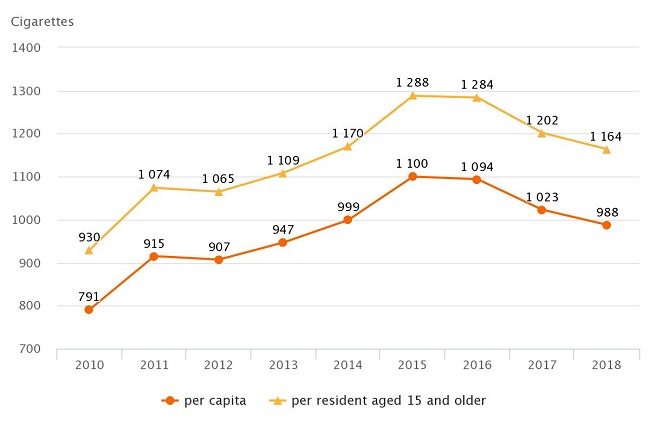
- In 2018, against 2017, the production of cigarettes increased by 7.4%, exports increased by 8.6%, while imports decreased by 12%.
- In 2018, against 2017, retail prices of tobacco products grew by 7.6%. The growth in prices of cigarettes was conditioned by a higher excise duty applied since 1 March 2018.
- In 2018, 1,652 persons died due to smoking-related malignant neoplasms, which is by 2 more than in 2017; most of them (79.8%) were males. In 2018, there were 59 deaths from smoking-related malignant neoplasms per 100 thousand population (urban population – 53, rural population – 70).








 «The Baltic Course» Is Sold and Stays in Business!
«The Baltic Course» Is Sold and Stays in Business!

